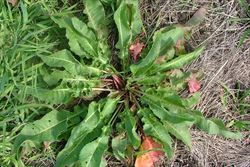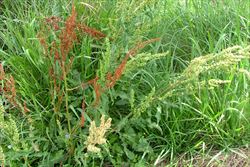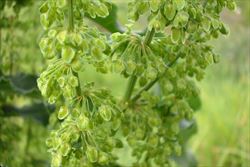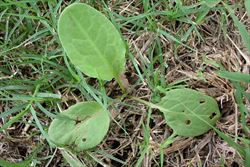Click on images to enlarge

infestation of young plants (Photo: Sheldon Navie)

basal rosette of curled leaves (Photo: Sheldon Navie)

habit in flower (Photo: Sheldon Navie)

habit in fruit (Photo: Sheldon Navie)

large lower leaves (Photo: Sheldon Navie)

smaller upper leaves and large branched flower clusters (Photo: Sheldon Navie)

flowers (Photo: Sheldon Navie)

close-up of flowers (Photo: Greg Jordan)

immature fruit (Photo: Sheldon Navie)

mature seed-heads (Photo: Sheldon Navie)

close-up of mature fruit (Photo: Sheldon Navie)

seedling (Photo: Sheldon Navie)
Scientific Name
Rumex crispus L.
Family
Polygonaceae
Common Names
curled dock, curly dock, curlyleaf dock, narrow dock, narrowleaf dock, sour dock, yellow dock
Origin
Native to northern Africa (i.e. Algeria, Egypt, Libya, Morocco and Tunisia), the Canary Islands, Europe, western and northern Asia (i.e. Afghanistan, Iran, Iraq, Lebanon, Syria, Turkey, Armenia, Azerbaijan, Georgia, Kazakhstan, Kyrgyzstan, Tajikistan, Uzbekistan, Russia, Mongolia, China, Japan, Korea and Taiwan), the Indian Sub-continent (i.e. Pakistan) and parts of south-eastern Asia (i.e. Myanmar and Thailand).
Naturalised Distribution
Widely distributed in the southern and eastern parts of the country. This species is very common in Victoria, eastern New South Wales, Tasmania, south-eastern South Australia, south-eastern Queensland and south-western Western Australia. It is also present in other parts of Queensland and New South Wales and has been recorded in The Northern Territory.
Also widely naturalised in other parts of the world including tropical Africa, La Réunion, Papua New Guinea, New Zealand, North America (i.e. the USA, Canada and Mexico), Central America, South America (e.g. Chile, Colombia, Ecuador and Peru) and on many Pacific islands (e.g. the Galápagos Islands, Fiji, French Polynesia, New Caledonia and Hawaii).
Habitat
A common weed that is usually found growing in damp soils that are not highly acidic. It is a weed of crops, fallows, pastures, waterways, wetlands, riparian vegetation, roadsides, gardens, parks, disturbed sites and waste areas in temperate and sub-tropical regions.
Habit
A long-lived (i.e. perennial) herbaceous plant that forms a basal rosette of leaves at first, and later produces upright (i.e. erect) flowering stems with much-branched flower clusters up to 1.5 m tall.
Distinguishing Features
- a long-lived herbaceous plant forming a basal rosette of large curly leaves at first.
- it eventually produces a number of upright leafy stems which branch into densely clustered inflorescences.
- its stem leaves are smaller, narrower and stalkless.
- its inflorescences are green at first, but become reddish-brown as the fruit mature.
- its small fruit have a pronounced wing-like projection (3-6 mm long) that is covered with obvious net-like veins.
Stems and Leaves
The stems may be green or reddish in colour, either smooth or slightly ribbed, and are always hairless (i.e. glabrous). They are upright (i.e. erect) or semi-upright (i.e. ascending) and are generally unbranched below the flower clusters.
The leaves have stalks (i.e. petioles) that are 1.5-11 cm long and the leaf blades have distinctly curled, crisped or undulating margins. They are large, especially in the rosette stage of growth, with oval to elongated (i.e. lanceolate) leaf blades (11-60 x 1.5-10 cm in size). The tips of the leaves are pointed (i.e. acute apex) and the leaf bases vary between those which taper to the petiole (i.e. attenuate) to those which have pronounced wings (i.e. hastate). Stem leaves gradually reduce in size towards the top of the plant and become narrower.
Flowers and Fruit
The flower clusters (i.e. inflorescences) are branched and somewhat leafy in the lower parts. They are comprised of many small greenish or reddish-tinged flowers arranged small clusters along elongated branches. Flowering occurs mostly during spring and summer.
The fruit are three-sided nuts and turn reddish-brown in colour as they mature. These fruit usually have a wing-like projection (3-6 mm long) covered with obvious net-like veins. The seeds are dark brown, angular, glossy, and about 2 mm long.
Reproduction and Dispersal
This species reproduces by seed, which are probably mainly dispersed by water and in mud attached to animals and vehicles. It is sometimes also spread in contaminated agricultural produce (i.e. fodder and pasture seed).
Environmental Impact
Curled dock (Rumex crispus) is regarded as an environmental weed in Victoria and Western Australia.
Legislation
Not declared or considered noxious by any state government authorities.
Management
For information on the management of this species see the following resources:
- the Tasmanian Department of Primary Industries and Water Weed Service Sheet on docks, which is available online at http://www.dpiw.tas.gov.au.
Similar Species
Curled dock (Rumex crispus) can be distinguished from other docks (Rumex spp.) and sorrel (Acetosella vulgaris) by the shape of its fruit. Sorrel (Acetosella vulgaris) has fruit with no projections, swamp dock (Rumex brownii) has fruit with 4-6 small hooked teeth about 1 mm long, lesser wiry dock (Rumex dumosiformis) has fruit with two long teeth (3-4 mm long) on either side, while the fruit of curled dock (Rumex crispus) are broadly winged.

